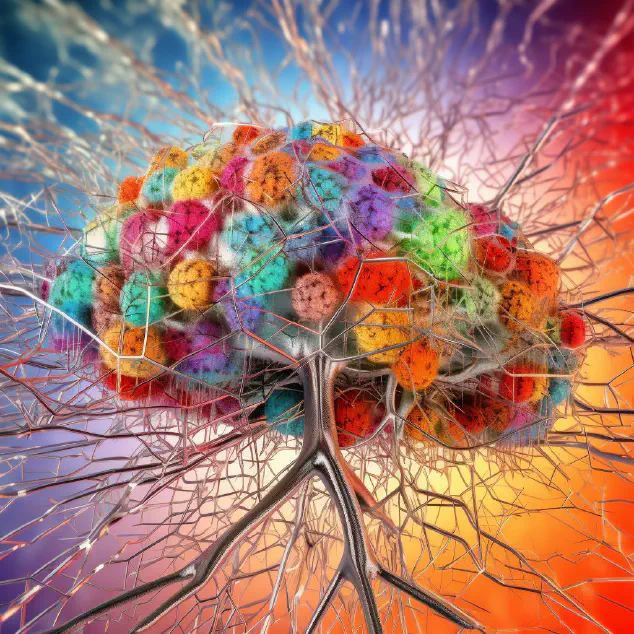
Introduction
Neuroplasticity is one of the most important discoveries in neuroscience in recent decades because of its potential ability to change the brain and improve our lives. The concept of neuroplasticity refers to the brain’s ability to change its structure and function in response to external stimuli, experiences, and learning. This means that the brain is not a fixed and immutable organ as we used to believe, but a dynamic and adaptable system that can be modified based on our behavior, thoughts, and emotions.
The implications of neuroplasticity are enormous, as it means that we can deliberately and intentionally change our brain for the better. By understanding the science of neuroplasticity, we can learn how to enhance our learning and memory, overcome brain damage, improve our mood and stress management, become more resilient to trauma, increase our cognitive flexibility and creativity, and so on.
In this article, we will explore ten amazing ways neuroplasticity can change your brain, and how you can leverage this knowledge to improve your wellbeing and performance. From enhanced perception and sensory processing to better decision making and problem-solving, neuroplasticity offers a myriad of possibilities for personal growth and transformation. So, let’s dive into the world of neuroplasticity and see how it can revolutionize your brain and your life.
1. Enhanced Learning and Memory
Neuroplasticity plays a crucial role in the ability of the brain to learn and remember information. The human brain is capable of rewiring and adapting to new experiences, which enables us to learn new skills and store new memories throughout our lives.
How neuroplasticity can improve learning and memory
Various studies have shown that the process of learning and memory formation is closely related to the phenomenon of neuroplasticity. Neurons in the brain can create new connections and strengthen existing ones, which facilitate the encoding, storage, and retrieval of information.
For instance, exciting research has found that stimulation of the hippocampus, an area of the brain responsible for memory formation, can increase neuroplasticity and significantly improve learning and memory. Additionally, the process of sleep also plays a crucial role in enhancing neuroplasticity and consolidating memories.
Examples of techniques that can enhance neuroplasticity for this purpose
There are several ways we can harness neuroplasticity to improve our ability to learn and remember information:
- Meditation and mindfulness practices have been shown to improve cognitive functions, including attention and memory.
- Regular exercise is known to enhance neuroplasticity, especially in the hippocampus, leading to better learning and memory function.
- Engaging in mentally stimulating activities such as reading, learning a new language, or playing an instrument can also help to maintain and enhance neuroplasticity.
By utilizing these techniques and taking advantage of the brain’s natural ability to adapt and rewire, we can improve our learning and memory abilities, regardless of our age or cognitive abilities.
2. Overcoming Brain Damage
Neuroplasticity is an incredibly powerful tool for overcoming brain damage. In cases where an individual has suffered from damage to the brain due to an injury or illness, neuroplasticity allows the brain to form new connections and rewire itself to compensate for the lost function.
One example of this is in the case of stroke patients. When a stroke occurs, certain areas of the brain can be damaged, leading to a loss of movement or function on one side of the body. Through neuroplasticity, the brain can rewire itself to use other areas to control movement and make up for the lost function. This can lead to significant improvements in movement and coordination, even in cases where traditional therapies have failed to make an impact.
Another example is in the case of traumatic brain injury (TBI). In some cases, TBI can result in long-term cognitive deficits that can severely impact an individual’s quality of life. Through neuroplasticity, however, the brain can form new connections and rewire itself to compensate for the damage. This can lead to improvements in memory, attention, and other cognitive functions, even years after the initial injury.
Overall, the potential of neuroplasticity to overcome brain damage is significant. By working with professionals trained in neurorehabilitation and utilizing techniques that enhance neuroplasticity, individuals with brain damage can often make significant progress in their recovery and regain lost function.
3. Improved Mood and Stress Management
Neuroplasticity has been found to have a significant impact on mood and stress levels. The brain has the ability to learn how to regulate emotions more effectively through neuroplasticity, which can lead to more positive moods and better stress management.
Research has shown that mindfulness meditation, which is a practice that involves focusing one’s attention on the present moment, can help enhance neuroplasticity in areas of the brain that are associated with better emotional regulation and reduced stress. Additionally, regular exercise has also been found to increase the production of neurochemicals that promote positive mood and improve stress management.
A study conducted by the National Institutes of Health found that individuals with higher levels of neuroplasticity had a more positive outlook on life and were better able to regulate their emotions in response to stress. Other studies have shown that regular practice of stress-reducing techniques, such as deep breathing or yoga, can help improve the brain’s ability to self-regulate in response to stress.
It is important to note that while neuroplasticity can enhance mood and reduce stress, it is not a cure-all for mental health disorders such as depression or anxiety. However, intentionally harnessing neuroplasticity through practices such as mindfulness meditation or exercise can be a powerful tool in improving one’s emotional and mental wellbeing.
4. Greater Resilience to Trauma
Trauma can have a profound impact on individuals, causing long-lasting emotional and psychological harm. However, research has shown that neuroplasticity can help individuals overcome the effects of trauma and build greater resilience.
Neuroplasticity allows the brain to restructure and create new neural connections, which can be crucial in overcoming traumatic experiences. For example, studies have shown that individuals who have experienced trauma have increased activity in the amygdala, which is responsible for processing emotions like fear and anxiety. However, through techniques like exposure therapy, where individuals are gradually exposed to the source of their trauma in a controlled and safe environment, this activity can be reduced.
In addition, techniques like cognitive restructuring, which help individuals challenge negative thoughts and beliefs related to their trauma, can also enhance neuroplasticity and promote greater resilience.
One study found that survivors of childhood abuse who participated in a mindfulness-based stress reduction program showed decreased symptoms of post-traumatic stress disorder (PTSD) and improved resilience to trauma. This suggests that certain techniques can help enhance neuroplasticity and improve the brain’s ability to recover from traumatic experiences.
Overall, greater resilience to trauma is one of the many amazing ways that neuroplasticity can transform the brain. By intentionally harnessing neuroplasticity through targeted techniques and interventions, individuals can overcome the effects of trauma and build greater emotional and psychological resilience.
5. Increased Cognitive Flexibility
Cognitive flexibility refers to the ability to switch between thinking about two different concepts, tasks, or perspectives. It is a key component of executive function, allowing individuals to adapt to new situations and solve problems. Research has shown that neuroplasticity plays a crucial role in improving cognitive flexibility.
Neuroplasticity enables the brain to change its neural connections in response to experience and learning. This leads to the creation of new neural pathways, allowing different regions of the brain to communicate and work together more efficiently.
How neuroplasticity improves cognitive flexibility
One way in which neuroplasticity improves cognitive flexibility is by promoting the growth of new neurons in the brain. This process, known as neurogenesis, occurs primarily in the hippocampus, a region of the brain that is crucial for learning and memory. Studies have shown that increased neurogenesis is linked to better cognitive flexibility.
Neuroplasticity also improves cognitive flexibility by strengthening existing neural connections and facilitating the creation of new ones. This enables the brain to form more complex networks and switch between different modes of thinking more easily.
Techniques for enhancing cognitive flexibility
Several techniques can be used to enhance cognitive flexibility and promote neuroplasticity. These include:
-
Mindfulness meditation: Mindfulness meditation involves focusing attention on the present moment and observing thoughts and emotions without judgment. It has been shown to improve cognitive flexibility and increase gray matter volume in the prefrontal cortex, a region of the brain that is involved in executive function.
-
Cognitive-behavioral therapy: Cognitive-behavioral therapy (CBT) is a form of psychotherapy that aims to change negative thought patterns and behaviors. It has been shown to improve cognitive flexibility and reduce symptoms of anxiety and depression.
-
Exercise: Exercise has been shown to promote neuroplasticity and improve cognitive function. Aerobic exercise, in particular, has been linked to improvements in cognitive flexibility.
-
Learning a new skill: Learning a new skill, such as a musical instrument or a foreign language, can promote neuroplasticity and improve cognitive flexibility.
Conclusion
Neuroplasticity plays a crucial role in improving cognitive flexibility. By promoting the growth of new neurons and strengthening existing neural connections, neuroplasticity enables individuals to adapt to new situations and switch between different modes of thinking more easily. Techniques such as mindfulness meditation, cognitive-behavioral therapy, exercise, and learning a new skill can be used to enhance cognitive flexibility and promote neuroplasticity.
6. Better Attention and Focus
Attention and focus are crucial skills in today’s world of constant distractions. Fortunately, neuroplasticity offers numerous ways to enhance our attention and focus abilities.
Meditation
Meditation is a proven technique for enhancing attention and focus. Research has shown that practicing mindfulness meditation can help people improve their focus, reduce mind wandering, and enhance cognitive flexibility.
Cognitive Training
Cognitive training is another technique that can improve attention and focus. These training programs involve tasks that require sustained attention and working memory. Studies have shown that using cognitive training programs can enhance attention, working memory, and cognitive control.
Exercise
Physical exercise is another way to enhance attention and focus. Exercise promotes the production of neurotrophic factors that increase the plasticity of the brain. This plasticity leads to improvements in attention and focus.
Sleep
Getting enough sleep is crucial for attention and focus. Studies have shown that sleep deprivation can impair our ability to sustain attention and attend to relevant information. Getting the recommended amount of sleep can improve attention and focus and help prevent cognitive decline.
Avoiding Multitasking
Multitasking is a common practice in our daily lives, but it can impair our attention and focus. When we switch between tasks, our attentional resources are depleted, leading to attentional errors. Focusing on one task at a time can improve attention and reduce errors.
Mindfulness-Based Cognitive Therapy
Mindfulness-Based Cognitive Therapy (MBCT) is a more specific application of mindfulness-based practices. It combines mindfulness practices with cognitive-behavioral therapy. MBCT has been shown to reduce symptoms of depression, improve attention, and enhance cognitive control.
In conclusion, neuroplasticity provides several ways to enhance our attention and focus abilities. By practicing mindfulness, cognitive training, exercise, getting enough sleep, avoiding multitasking, and using mindfulness-based cognitive therapy, we can improve our attention and focus and lead more productive and fulfilling lives.
7. Enhanced Perception and Sensory Processing
Neuroplasticity has been shown to play a critical role in enhancing sensory perception and processing. This is because the brain is able to adapt and reorganize itself based on the input it receives from the senses. Here are some ways in which neuroplasticity can enhance perception and sensory processing:
Synaptic changes
One way in which neuroplasticity enhances perception and sensory processing is through synaptic changes. Synapses are the connections between neurons that allow them to communicate with each other. When new sensory experiences occur, synapses can be strengthened or weakened depending on the relevance of the input. For example, if you are exposed to a certain odor repeatedly, the brain can strengthen the synapses between the neurons that process that odor, making it easier to detect and identify in the future.
Sensory substitution
Another way in which neuroplasticity enhances perception and sensory processing is through sensory substitution. This is the process of using one sensory modality to replace another that is no longer functioning properly. For example, if someone loses their vision, they may compensate by using touch or hearing to navigate and perceive their environment. The brain is able to adapt to these new inputs and process them in a way that allows the person to perceive the world around them.
Brain training exercises
Brain training exercises have also been shown to enhance perception and sensory processing through neuroplasticity. These exercises involve practicing tasks that require attention and processing of sensory information. For example, playing a video game that requires quick reactions to visual stimuli can strengthen the neural circuits involved in visual processing. This can lead to improved visual perception and processing in everyday life.
Cross-modal plasticity
Cross-modal plasticity is the ability of the brain to reorganize itself in response to changes in sensory input. For example, blind individuals have been shown to have increased activity in the areas of the brain that process sound and touch. This is because the brain has reorganized itself to compensate for the lack of visual input. Cross-modal plasticity can also occur in response to sensory deprivation or overstimulation.
Conclusion
Enhanced perception and sensory processing are just some of the ways in which neuroplasticity can transform the brain. By understanding how neuroplasticity works, we can intentionally harness it to improve our lives in meaningful ways. Whether it’s through brain training exercises, sensory substitution, or simply exposing ourselves to new experiences, we have the power to shape our brains and enhance our perception of the world around us.
8. Improved Motor Skills
Motor skills refer to the ability to coordinate movements of the muscles and limbs to achieve a goal, and neuroplasticity can help improve these skills. Research has shown that the neural circuits responsible for motor skills are highly adaptable and can change in response to experience, making it possible to improve even in adulthood.
How neuroplasticity can improve motor skills
One way that neuroplasticity can improve motor skills is by strengthening the connections between neurons in the brain. When a specific movement is performed repeatedly, the neurons that are responsible for controlling that movement become activated more frequently, and the connections between them become stronger. Over time, this makes it easier to perform the movement accurately and efficiently.
Another way that neuroplasticity can improve motor skills is through the growth of new neurons and connections. It was previously believed that new neurons could not be generated in the adult brain, but research has shown that this is not the case. Neurons can continue to be generated in certain areas of the brain, such as the hippocampus, and this process can be enhanced through physical activity and other stimulation.
Techniques for enhancing neuroplasticity for improved motor skills
There are several techniques that can be used to enhance neuroplasticity and improve motor skills. These include:
-
Practice and repetition: Repeatedly practicing a specific movement is one of the most effective ways to strengthen the connections between neurons and improve motor skills. This can be done through regular exercise, sports training, or other physical activities.
-
Variation in practice: Varying the way a movement is performed can help stimulate the growth of new connections between neurons, making it easier to perform the movement in different contexts. For example, practicing a tennis serve from different angles or at different speeds can help improve overall accuracy and coordination.
-
Visualisation: Mentally rehearsing a movement can activate many of the same neural pathways as physically performing the movement, leading to improvements in motor skills. This technique is often used in sports training, where athletes will visualise themselves performing a specific skill or movement before actually attempting it.
-
Cross-training: Engaging in different types of physical activities can help stimulate the growth of new neurons and connections, leading to improved motor skills. For example, incorporating yoga or dance into a fitness routine can help improve overall coordination and balance.
Conclusion
Improved motor skills can have a significant impact on a person’s quality of life, particularly in areas such as sports or physical therapy. By understanding how neuroplasticity can improve motor skills, individuals can intentionally engage in practices and activities that promote neural growth and development, leading to improved coordination, accuracy, and efficiency of movement.
9. Better Decision Making
Neuroplasticity can also enhance decision making and problem-solving abilities. According to a study published in the journal Nature Communications, individuals who practiced a visual working memory task for just two weeks showed improvements not only in their working memory but also in their decision making. This suggests that practicing certain tasks can improve overall cognitive function and decision making abilities.
Moreover, neuroplasticity can help individuals develop cognitive strategies to evaluate and analyze information, leading to better decision making. An example of this is cognitive behavioral therapy (CBT), which utilizes neuroplasticity to rewire negative thought patterns and replace them with more positive and adaptive ones.
Additionally, meditation and mindfulness practices can enhance neuroplasticity and improve decision making abilities. One study found that regular meditation practice led to increased activity in the pre-frontal cortex, the area of the brain responsible for decision making and critical thinking.
In summary, by utilizing specific techniques that enhance neuroplasticity, individuals can cultivate better decision making skills and critical thinking abilities.
10. Increased Creativity
Neuroplasticity is not only important for improving cognitive and physical abilities, but it can also enhance our creative potential. Creative thinking is an essential skill that can bring new ideas, solutions, and perspectives to various aspects of our lives, including work, relationships, and personal growth. Neuroplasticity can help us enhance this ability in the following ways:
Neural Pathways and Brain Connectivity
The brain is a complex network of neural pathways that connect different regions responsible for various functions. Neuroplasticity can help boost these connections and strengthen neural pathways, leading to increased creativity. As we engage in creative activities and novel experiences, our brain creates new neural connections, facilitating the flow of ideas and promoting innovative thinking.
Divergent Thinking
Divergent thinking is a critical component of creativity that allows us to generate multiple ideas and solutions to a problem. Neuroplasticity can foster this ability by promoting the growth of new neural pathways that facilitate free-flowing and flexible thinking. As we engage in creative tasks like brainstorming, meditation, or artistic endeavors, our brain develops new pathways that allow us to think beyond conventional approaches and come up with more innovative solutions.
Enhancing Imagination and Visualization
Neuroplasticity can enhance the brain’s ability to visualize and imagine, promoting creativity in various contexts. As we engage in creative tasks like painting, drawing, or storytelling, regions of the brain responsible for imagination and visualization become more active and develop new neural pathways to support these abilities.
Cross-Modal and Associative Thinking
Neuroplasticity can also enhance cross-modal and associative thinking, allowing us to connect seemingly unrelated concepts and ideas, leading to novel insights and solutions. By engaging in tasks that require linking different types of sensory experiences, like listening to music while painting or imagining a story while walking, our brain develops new pathways that promote associative thinking and enhance our creative potential.
In conclusion, neuroplasticity can transform our brains to enhance creativity in various contexts and promote innovative thinking. By engaging in creative activities and novel experiences, we can harness the power of neuroplasticity to explore new ideas, perspectives, and solutions to problems.
Conclusion
In summary, neuroplasticity is an incredible ability of the human brain to adapt and change throughout our entire lives. Through intentional efforts and techniques, we can enhance neuroplasticity to transform our brains in amazing ways.
We have seen how neuroplasticity can improve learning and memory, help the brain recover from damage, enhance mood and stress management, promote resilience to trauma, improve cognitive flexibility, attention and focus, sensory processing, motor skills, decision making, and creativity.
These changes have significant implications for our personal and professional development, as well as for our overall well-being. By intentionally practicing techniques that enhance neuroplasticity, we can improve our cognitive and physical abilities, as well as our emotional and creative expression.
As we continue to research and learn more about neuroplasticity, we can expect to unlock even greater potential for our brains, and use this knowledge to improve our lives in profound ways.


